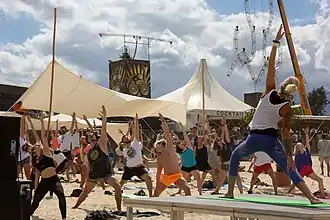Yoga in Germany
Yoga in Germany is the practice of yoga, whether for exercise, therapy, or other reasons, in Germany.

History
Nazi era
The German historian and yoga teacher Mathias Tietke wrote that Nazi leaders including the SS commander Heinrich Himmler were interested in yoga. Himmler studied the Bhagavad Gita and believed it justified genocidal violence such as the holocaust. A captain in the SS, Jakob Wilhelm Hauer, author of the 1934 Eine indo-arische Metaphysik des Kampfes und der Tat, die Bhagavadgita in neuer Sicht mit Übersetzungen ("An Indo-Aryan metaphysics of struggle and action, the Bhagavadgita in a new perspective with translations") seems to have persuaded Himmler that "yoga can internally arm us to prepare us for the forthcoming battles."[1][2][3]
Postwar

From the 1940s, Sivananda's teachings attracted the interest of Boris Sacharow, who became a disciple by post, taking up Sivananda's standing offer of that service; he earned the diploma of the Divine Life Society and the title of yogiraj ("yoga master") in 1947. Sacharow had founded Germany's first school of yoga in Berlin in 1921; it was destroyed by bombing in the Second World War, and reestablished in 1946. It taught the Rishikesh Reihe ("Rishikesh sequence") of 12 asanas. The anthropologist Sarah Strauss noted that the sequence was still inspiring German students of yoga to travel to Rishikesh in the 1990s.[4]
The Romanian scholar Mircea Eliade's 1954 book Le Yoga: Immortalité et Liberté[5] appeared in a "popular"[6] German translation in 1960. Based on the Hatha Yoga Pradipika, it presented yoga asanas as a way of preparing for pranayama (yoga breathing) and meditation.[6]
Sivananda Yoga, founded by Swami Vishnudevananda, has centres in Berlin and Munich.[7] In 1992, a student of Vishnudevananda, Sukadev Volker Bretz, began to teach his own style of yoga, and in 1995 launched "Yoga Vidya". By 2017, it had 100 yoga schools and four seminar centres in Germany, and had trained over 10,000 yoga teachers.[8]
In 1994, Iyengar Yoga Deutschland was founded, beginning informally with 50 members who taught each other. Teachers from the central institute in Pune were then invited to come and teach, leading to the creation of an annual convention, to which B.K.S. Iyengar came in 1996, and his daughter Geeta Iyengar in 2002 and 2009.[9]
By 2016, according to a market survey by the Gesellschaft für Konsumforschung, around 3 million people in Germany practiced yoga regularly, and some 10 million had tried it. Among the major cities, Berlin had some 300 yoga studios, while Munich had about 200.[10]
Professionalisation
Yoga teacher training standards
In Germany, standards are set by the (German) Yoga Teachers' Union (BDY), founded in 1967; these require 720 hours of class instruction over a period of four years, assessed by an oral examination, a written examination, and a practical teaching demonstration.[11]
Yoga therapy
Yoga is entering the German healthcare system as a form of therapy. Yoga teachers in Germany must obtain qualifications in psychotherapy or medicine as well as in yoga teaching to use the description "yoga therapy".[12]
Research
The University of Hamburg has established a Center for Yoga Studies to conduct research into the history and practice of yoga and meditation.[13]
References
- YJ Editors (12 April 2017). "Nazi Leaders Fascinated By Yoga". Yoga Journal.
- Tietke, Mathias (2011). Yoga im Nationalsozialismus: Konzepte, Kontraste, Konsequenzen [Yoga in National Socialism: Concepts, Contrasts, Consequences]. Ludwig. ISBN 978-3869350134.
- Day, Matthew (22 February 2012). "Nazi leader Heinrich Himmler a fan of yoga". The Daily Telegraph.
- Strauss, Sarah (2005). Positioning Yoga: balancing acts across cultures. Berg. pp. 41-42. ISBN 978-1-85973-739-2. OCLC 290552174.
- Eliade, Mircea (2009) [1954]. Yoga: Immortality and Freedom. Translated by Willard R. Trask. Princeton University Press.
- Misiak, Anna (2019). "Why We Practice: A Short History of Yoga in the West". Yoga International.
- "Sivananda Yoga Centres in Europe". Sivananda Yoga Europe. Retrieved 4 September 2019.
- "Germany's Yoga Vidya a success story in Europe". Religion Watch. 33 (2). 2017. Yoga Vidya's own website is at "Yoga Vidya – Europe’s biggest Yoga Institution".
- "Geschichte". Iyengar Yoga Deutschland (in German). 2019.
- "Yoga boom in Germany". Deutschland.de. 20 June 2016.
- Mullins, Daya. "Yoga and Yoga Therapy in Germany Today" (PDF). Weg Der Mitte. Retrieved 4 September 2019.
- Cramer, Holger (2018). "Yoga Therapy in the German Healthcare System". International Journal of Yoga Therapy. 28 (1): 133–135. doi:10.17761/2018-00006. ISSN 1531-2054.
- "Center for Yoga Studies". Universität Hamburg. 14 November 2018. Retrieved 9 November 2020.
